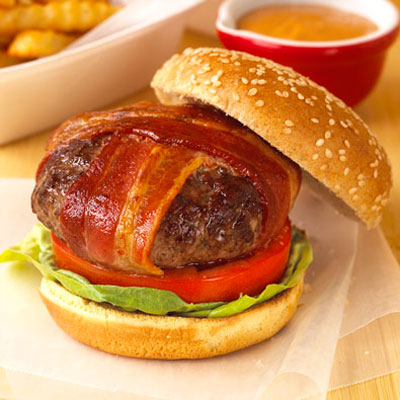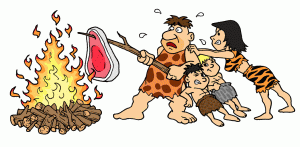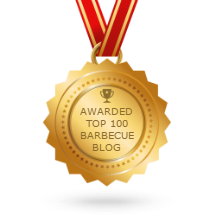History of the Beloved American Hamburger – Guest post
 Burgers, my go to meal anyplace anytime. You can find hamburgers on the grill everywhere, from the neighbors backyard to fancy restaurants, grilled, BBQ'd, steamed, griddled and hung, they are all wonderful. But have you ever wondered how we came to love them so?
Burgers, my go to meal anyplace anytime. You can find hamburgers on the grill everywhere, from the neighbors backyard to fancy restaurants, grilled, BBQ'd, steamed, griddled and hung, they are all wonderful. But have you ever wondered how we came to love them so?
Read on with our newest guest writer Arnie Tomaino from http://www.grilljunkie.com/ as he gives us a history lesson on the Hamburger.
A Mercifully Brief yet Satiating History of the Beloved American Hamburger
By Arnie Tomaino
There is nothing more irresistible and soul-satisfying than a perfectly prepared and skillfully grilled hamburger. Whether it be topped with bacon, smoked meats, cheese, a delicious sauce, salsa, or even stuffed, there is no doubt that the most memorable burgers are drenched in sustenance, flavor, and pure satisfaction. Most folks will be interested to know that the treasured hamburger is also drenched in a flavorful, if not controversial history as well.
An important first step in unveiling the history of the iconic burger is to define it, so as to fully appreciate the lineage that leads us to today’s delectable grilled creation, beloved by not only grilling-obsessed Americans but by folks all over the world. According to Josh Ozersky, author of, “The Hamburger: A History (Icons of America)”, a hamburger is, at its most basic level, “a ground beef patty served on a white enriched bun.” Now, we all are guilty of helping to enhance the basic burger definition and design by leveraging the best choice of meats and fat content, mixing meats, adding bacon, cheese, salsas, spices, and toppings, while also experimenting with the traditional bun, but let’s go back to simpler times and investigate where it all began.
In the beginning…
Many sources claim that the history of the hamburger begins with the Mongols between the years 1219 and 1221. Led by Genghis Khan in his insatiable quest for power and land, his fast-moving, cavalry-based army known as the Golden Horde rode small sturdy ponies and conquered two thirds of the then known world. Driven by Kahn’s notorious tenacity, they remained in their saddles for long periods of time, sometimes days without ever dismounting. They had little opportunity to stop and build a fire for their meal.
As the army traveled, they needed food that could be carried on their mounts and eaten easily with one hand while they rode. An easily accessible meat was an ideal choice. They would use scrapings of lamb or mutton which were formed into flat patties and salted to preserve them a bit. They softened the meat by placing them under the saddles of their horses while riding into battle. When it was time to eat, the meat would be consumed raw, having been tenderized by being sandwiched between the saddle and the back of the horse. By adding a few spices, whenever available, these strips of raw beef became a convenient meal to these independent, swift-moving riders not keen to frequent dismount.
It is said, then, that the Mongols, under the rule of Genghis Khan’s grandson, Khubilai Khan brought the practice to Russia during the invasion of Moscow wherein it evolved into the dish we know today as Steak Tartare (Tartars being their name for the Mongols). As global trade expanded, merchants and seafarers brought this idea back to the port city of Hamburg, Germany, where the locals decided to add heat to the equation, mold it into a more uniformed steak shape, creating something that, outside of Hamburg, was referred to as “Hamburg steak.”
Of course, as it is succinctly noted in John T. Edge's book “Hamburgers & Fries, An American Story” (Putnam, 2005), this evolutionary path of the hamburger from the Mongols to Hamburg to America may not necessarily have followed a straight line. As Mr. Edge writes, “The history of proletarian dishes like hamburgers is rarely explained by a linear progression of events.” But enough time spent in historical European and Asian territory; let's make the leap and cross the shores to the Americas. Along the way, somehow, mainly through the mass emigration to a new land, ground beef gets to America, is molded into a patty and is put on a bun. But how?
The answer is most likely from a progressive introduction of the Hamburg Steak during the European emigration to America in the late 1800’s on the German Hamburg-Amerika line boats combined with the sequential invention of the mechanical meat chopper. Now several people who claim to be the descendents of the hamburger’s inventor dispute what happened next. The story used to be that the first hamburger was served up at the 1904 St. Louis World's Fair. This sandwich was made with a cooked patty of ground beef on a hard roll. Of course there are earlier references but this might very well be the first time a cooked patty hit the bun. This might be the oldest verifiable instance of the hamburger being served. However, there are many more who claim to be the inheritors of the burger’s controversial and flavorful fame.
There are currently three major claims staked on the confusing and contradictory map of American hamburger history. Each with its own story and individual claim as well respective support and opposition. They are:
Louis' Lunch: This New Haven, Connecticut, eatery claims to have invented our treasured burger in 1900. The legendary eatery claims, that: “One day in the year 1900 a man dashed into a small New Haven luncheonette and asked for a quick meal that he could eat on the run. Louis Lassen, the establishment's owner, hurriedly sandwiched a broiled beef patty between two slices of bread and sent the customer on his way, so the story goes, with America's first hamburger.”
Charlie Nagreen: It's said that Charlie started selling meatballs at the age of 15 at the summer fair in Seymour, Wisconsin. Charlie was known by many as being very resourceful young man with a very gregarious personality. After not experiencing much success selling the meatballs, he came up with a new idea. It wasn't that people at the fair did not like meatballs, they wanted to take the meal with them as the wandered through the fairgrounds. He realized people could take this meal with them if he simply smashed the meat together between two pieces of bread. He called it a “hamburger” and yes, in 1885 the burger was born at the fair in Seymour, Wisconsin.”
Menches Brothers: The brothers' descendents, who now operate a small chain in Ohio called, not surprisingly, Menches Brothers, claim that their great-grandfather and his brother (Charles and Frank, respectively) invented the dish at an 1885 fair in Hamburg, New York. The brothers originally sold sausages but ran out and were forced to use ground beef, which at the time was considered to be lower in status as compared to other meats. John Menches, in a March 2005, BusinessWeek “Small Biz” story, says, “Faced with nothing to sell at all, they fried [the ground beef] up, but it was too bland. My grandfather decided to put coffee, brown sugar, and some other household ingredients in it and cooked up the sandwich. My great-uncle Frank served the first sandwich, a gentleman tasted it and said, ‘What do you call it?' Uncle Frank didn't really know what to call it, so he looked up and saw the banner for the Hamburg Fair and said, ‘This is the hamburger.' “
So who invented the hamburger? We’re all clear now right?
We never claimed that it would be easy, but we did promise that it would be both deliciously interesting and we would keep it mercifully brief! In any case we’re just glad that someone did invent, if not discover the hamburger, so we can now enjoy this treat celebrated around the world. For those who would like to peel back a few more layers related to the very beginning of the treasured burger, its unique rise in American history, while also beginning your own individual quest to find the best burger in America, we strongly encourage you to read the following:
“The Hamburger: A History (Icons of America)”, by Josh Ozersky – (Yale University Press, 2008)
“Hamburgers and Fries, An American Story”, by John T. Edge – (Putnam 2005)
“Hamburger: A Global History” (RB-Edible) by Andrew F. Smith (Hardcover – Oct 7, 2008)
In the meantime, fire up that grill and let’s get grilling!
Author Biography
Arnie Tomaino
Arnie is the Founder and President of GrillJunkie, http://www.grilljunkie.com and has been a grilling enthusiast for as long as he could hold a spatula. Arnie is responsible for the overall vision, strategic direction, and brand development of GrillJunkie. A self-proclaimed “weekend grill warrior”, Arnie combines his passion for outdoor cooking and writing, with his business experience in the Retail, Consumer Products, and High-Tech arenas where he has served in many positions including Corporate Communications, Brand Development, Product Marketing, and Strategic Development.
Arnie is the author of “The GrillJunkie – Burger-a-Day Cookbook.” He has held membership in the National Barbecue Association, and the New England Barbecue Society. Arnie holds a Bachelors Degree from Villanova University and a Masters of Business Administration in Marketing from Northeastern University. He and his wife live in Chelmsford, Massachusetts with their three daughters.

